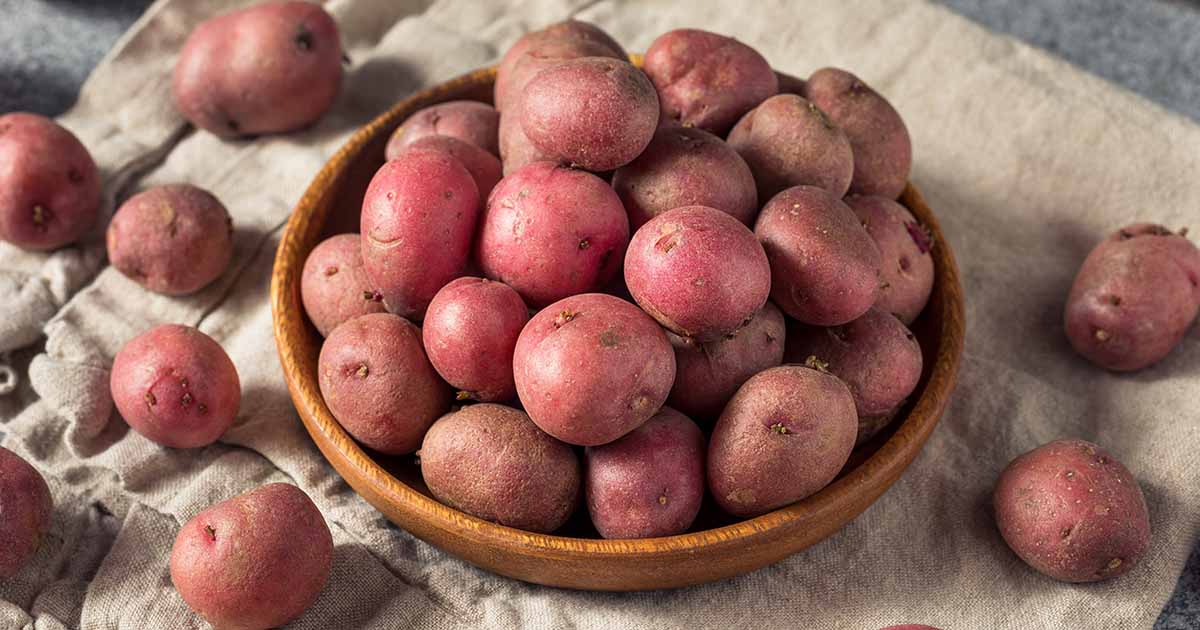‘Mountain Rose’ came to us from the mountainous Mile-High State’s Colorado State University as a cross between ‘All Red’ and an unnamed cultivar.
It’s ready as new potatoes after about 70 days and 120 for full maturity.
9. Red Chieftain
If you’re looking for a mid-season variety ready in under 100 days, with large, round to oval tubers and floury, fluffy white flesh, you’ve found one of the best.
‘Red Chieftain’ came about as a collaboration between the Iowa Agriculture and Home Economics Experiment Station and the USDA in 1966.
It’s resistant to scab, verticillium wilt, and late blight, and is a reliably high yielder.
The downside is that it doesn’t have the right qualities to make good chips or french fries, but you can’t find a better option for roasting or baking.


‘Red Chieftain’
Mouth watering? Mine too. Start your crop by grabbing some slips at High Mowing Seeds.
10. Red Gold
Named for its rosy flesh and sunny yellow flesh, ‘Red Gold’ is resistant to scab and potato virus and provides high yields of round, creamy tubers.
It’s ready after just 70 to 80 days for new potatoes or mid-season when full-sized. You might even be able to harvest two crops out of it, depending on where you live.
The downside, if you want to call it that, is that you have to eat them right away. These tubers don’t store well.
Guess that means you’ll need to be mashing, roasting, and frying to your heart’s content.


‘Red Gold’
This cold-climate favorite came to us in 1970, bred by Agriculture Canada, the University of Guelph, and the Ontario Ministry of Agriculture and Food.
You can find packets of 10 tubers available at Burpee.
11. Red La Soda
For southern growers or those in hot regions, ‘Red La Soda’ offers oblong tubers with deep, ruby-colored skin and waxy, white flesh while having good resistance to heat and drought.
The plants are extremely vigorous and ready in early- to mid-season, with an average maturation of 95 days.


The parent, ‘La Soda,’ was a cross between ‘Triumph’ and ‘Katahdin,’ bred as part of the Louisiana Agricultural Experiment Station breeding program in 1948.
Just a year later, a red mutant was discovered and released by the USDA and LAES in 1953.
You can pick up five pounds of seed potatoes via Amazon.
12. Red Luna
‘Red Luna’ was developed by Colorado State University as a high-yielding plant with tender, yellow flesh.
Both the low moisture content and the ruby skin makes it perfect for potato salads, so get yours in the garden for summer picnics!


‘Red Luna’
Resistant to black spot, the oblong tubers are ready mid-season after about 80 days, but earlies are ready in about 65 days.
Planning your summer menu? Grab 10 tubers from Burpee and start getting ready to dig in.
13. Red Pontiac
‘Red Pontiac’ is the one to reach for when you are beginning your potato-growing journey.
It’s incredibly adaptable and tough, forgiving inexperienced mistakes like underwatering, to provide huge yields of large, ruby tubers with white flesh in the late season after 100 days.
Or you can opt to harvest them early for new potatoes.
While it’s susceptible to most of the common diseases, ‘Dakota Chief,’ as it’s also known, is the perfect all-around variety whether you’re craving fries, chips, a heap of mashed potatoes, or a bunch roasted in butter with salt.


‘Red Pontiac’
It was registered in 1983 by the USDA after being developed from a mutation of ‘Pontiac’ discovered by grower J.W. Weston in Florida in 1945.
You can find packets of 10 tubers available at Burpee.
14. Red Thumb
You’ve probably guessed from the name that this is a fingerling type, producing long, oblong-shaped tubers that resemble thumbs. They can be up to four inches long and an inch wide.
It’s one of the earliest fingerlings, ready in under 90 days, plus it has some early blight and scab resistance.
Slice it open, and you’ll be greeted by creamy flesh shot through with rose red.
15. Sangre
‘Sangre,’ as you’d guess, has deep, blood-red skin wrapped around creamy white flesh.
It’s a little hard to find on the market, but it’s worth the search.
Colorado State Agricultural Experiment Station and USDA-Aberdeen Idaho bred this using ‘Viking’ and an unnamed cultivar, and it was released in 1982.


The medium, oblong tubers are flavorful and abundant. Start digging into this mid-season type after about 80 to 85 days.
No worries if you don’t want to eat them all right away, as they store well.
It resists early blight and potato virus, but is susceptible to verticillium wilt and fusarium rot.
16. Strawberry Paw
With ‘Strawberry Paw,’ the large, round, sometimes oblong tubers are a treat.

